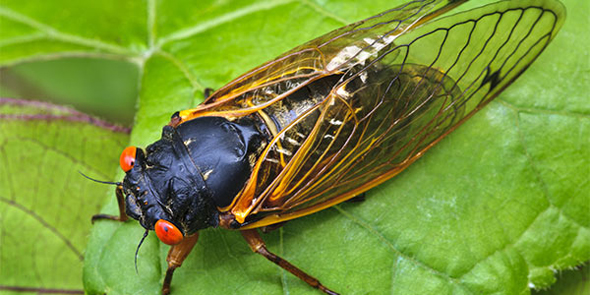
(Photo from the National Wildlife Federation)
The return of the Magi(cicada)
- Published: July 6, 2025
By Don Cipollini
In the early summer of 2021, Yellow Springs was treated to a deafening shrill on sunny afternoons that was enough to drive you crazy. That year, southwestern Ohio was graced with an emergence of 17-year periodical cicadas — genus Magicicada — of Brood X, the second emergence of this brood that I have witnessed in my 25 years in town. This year, we have only a smattering of periodical cicadas in town, but they increase in abundance as you head south toward Cincinnati. These are members of Brood XIV, a brood that I have now witnessed in Ohio, Kentucky and Pennsylvania.
Cicada broods are large groups of individuals that emerge at the same time in a particular geographic area and are labeled with Roman numerals, according to Charles Marlatt, the scientist who first identified and named many cicada broods at the turn of the 20th century. Brood X — “the great eastern brood” — is one of the larger broods, with large emergences in the Midwest and in several states along the east coast. Brood XIV is no slouch either; from southern Ohio, it stretches south to Tennessee and east to Maryland.
The cicadas that have emerged this year began their journey in 2008, when they dropped from tree branches as nymphs and burrowed in the soil. There, they spent the last 17 years attached to tree roots feeding on nutrient-poor sap and progressing through four developmental stages. They feed with a piercing and sucking mouthpart called a stylet, which is the required equipment of a true bug. Nymphs periodically reposition themselves underground and can burrow down to about eight feet.
How cicadas keep time belowground is somewhat of a mystery, but it likely involves “counting” seasonal pulses in sap flow as their host plants go through alternating cycles of growth and dormancy. When their internal clock strikes 17, they move upward in the soil and build an escape hatch called a turret at the soil surface in preparation for emergence when soil temperatures reach 64 degrees. This temperature threshold assures them that they are unlikely to freeze after emergence.
Upon emergence from the soil, cicadas will climb on the nearest upright object — even you, if you stand still long enough — shed the skin of their final nymphal instar and emerge as pale, red-eyed adults called imagoes. It is at this stage that you can eat them — which I have, breaded and deep-fried. Believe it or not, they taste like asparagus! Imagoes take a few days to stretch their wings and for their exoskeletons to fully harden and darken, preparing them to be functional adults capable of flying, singing and mating.
Once aboveground, the whole raison d’etre of periodical cicadas is to reproduce as much as possible before they get eaten or die. In fact, a major hypothesis for the evolution of the mass emergence phenomenon is to satiate predators with so many adults that at least some live long enough to reproduce. Just about anything that will accept meat in its diet will eat cicadas, from birds and snakes to your cats and dogs. They are non-toxic and harmless, but can be a little irritating on the way down — and sometimes on the way back up. When threatened, the best they can do is flap their wings while buzzing and clicking to startle predators. While folks have robbed stores wielding nothing but an outraged cicada, and wayward cicadas have led to more than one crashed car — it is all bark and no bite.
Male cicadas do all the singing, using a special organ called a tymbal located behind the wings on the abdomen, and their different calls have a variety of meanings. Mating calls can be so loud — on the order of 100 decibels — that male cicadas will disable their own eardrums to protect themselves from the noise. Other than housing their sound system, the abdomen of males is largely hollow inside. In response to male mating calls, females respond with wing flicks and clicks to indicate their interest and the fun begins. Cicadas can be best described as both promiscuous and polyamorous — they mate repeatedly with many partners.
Once mated, females begin the egg-laying process, which involves cutting slits in pencil-sized tree branches with a saw-like ovipositor and inserting 10–20 eggs at a time. A single female will lay up to 200 eggs during her lifetime and will die after she has deposited all her eggs — males are usually long dead by then. Eggs will hatch in 6–10 weeks and the nymphs that emerge will fall to the ground, dig in and start the process all over again. Cicadas will lay eggs on a wide variety of woody tree and shrub species, but they seem to have some preferences, like for oaks, and they will avoid most conifers. Oviposition damage by cicadas can injure small or weak trees — which can be protected by mesh netting — but it will have little long-term impact on large trees.
And then, almost as fast as it arose, the cacophony will cease and all that will be left will be the carcasses of billions of cicadas and lots of satiated predators. The mass emergence has numerous ripple effects on species like birds and small mammals that often experience temporary population increases for a few years after an emergence. Other insects can get temporary reprieve from predation as predators turn their attention to cicadas. Decomposing carcasses also serve as fertilizer for the very plants and trees on which the cicada nymphs feed, temporarily compensating for any of their feeding damage in the soil, where they will remain, silent and in darkness, for another 17 years.
*Yellow Springs resident Don Cipollini, Ph.D., is director of environmental sciences and a professor of biological sciences at Wright State University.
The Yellow Springs News encourages respectful discussion of this article.
You must login to post a comment.
Don't have a login? Register for a free YSNews.com account.















No comments yet for this article.